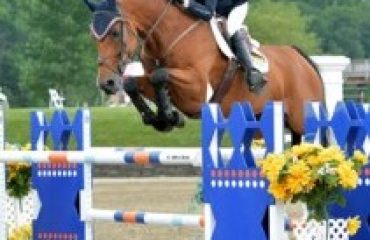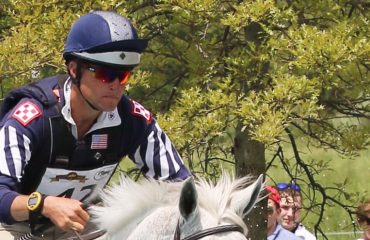
Boyd Martin riding Gloria Callen’s mare Welcome Shadow
Photo by Amber Heintzberger
Well known for both his fun-loving approach to life and his indefatigable work ethic, Boyd Martin has represented the U.S.A. in three-day eventing at two Olympic Games and two World Championships, and was on the gold-medal-winning Pan Am Games team in 2015. Boyd’s wife, Silva Martin, is a grand prix dressage rider and they have a son, Nox. Boyd and Silva train out of their own farm, Windurra USA in Cochranville, Pennsylvania, and spend winters at Stable View Farm in Aiken, South Carolina.
When do you shoe your horse in preparation for a competition?
The ideal time to get your horse shod in preparation for a big competition is about two weeks in advance. This means that if there’s a mishap with the shoeing, there’s time to do some emergency repair work so that you can still reach your goals. Try to plan your shoeing dates in your calendar so that you can time your appointments accordingly; there’s nothing worse than the feeling of sliding through mud at 570 meters per minute with only two shoes left on your horse’s feet! If there’s any chance of slippery or muddy going, also make sure the shoes are drilled and tapped so that you can use studs as needed.
How do you plan your horse’s training leading up to a big event?
Get yourself a calendar, or use the calendar app in your smartphone. As you go into the final weeks, try to have a day-to-day plan of what you want to do with your horse. Each day, have an idea of what you want to achieve and the exact time limitations of your training schedule. These plans can be changed according to your specific situation, but try to stick as close to them as you can.
As the competition approaches, it’s very easy to get irrational as far as what to do with your horse. Often your mind starts working overtime, trying to convince you to do more and more and more, but this usually leads to a painful breakdown rather than competitive success. The final stretch before a competition is when you should be perfecting your talents, not learning new skills.
The final week before the big competition, you’re going to have to walk the fine line of getting your horse perfectly tuned without going over the top and blowing it all. Make sure you have a few training sessions with your regular coach, and put the finishing touches on your performance. Often the only difference in the results you see between the good riders and the great riders is the preparation that has taken place before the event. All in all, it’s your attention to every small detail in preparation for this one event that will make the difference between winning and losing.
How do you keep your horse balanced and off the forehand when galloping cross-country?
One of the important factors to consider when training your horse to go cross-country is the way the horse gallops between fences. To me this is equally as important as teaching the horse to jump water, ditches and banks. When I’m schooling cross-country, the first section of my session would be galloping fences. I have a nice, big, flat field and I like to spend some time on single, galloping fences. If you think about a cross-country course, this type of jump makes up about 60 percent of the course anyway.
What I’m trying to encourage my horse to do is jump out of stride and when he lands he should gallop away from the jump. Each horse will like to travel in his own way. Within reason, you’ve got to allow the horse to gallop along the way he’s comfortable. Ideally his head should be up a bit and he should be carrying the bit forward lightly. I don’t like a horse that’s low in front, on his forehand and leaning on the bit. Similarly to dressage, if he’s in this undesirable frame, I’d try to rebalance the horse and lift his head and front end up, get him to a place where I’m comfortable and then soften my hand and allow him to gallop on. Eventually he’ll learn he has to land, lift his shoulder and wither and gallop on.
Like all riding, it’s not all about the hand — you also need to squeeze with the leg and try to lift his whole balance uphill and lighter. It’s a combination of the lower leg, a little seat and a bit of hand. To simplify, it’s a very similar process to a half-halt in the dressage or show jumping but the speed might be faster and the horse in a slightly different balance. When you look around the world, the good cross-country horses at the moment are coming out of Germany and their riders have simple bits and bridles, often just an egg-butt snaffle and no martingale, and these riders have done heaps of schooling and the horse is just gently balanced and turning and listening to the rider, all in this soft, uphill balance. Often this doesn’t come naturally, so as riders we have to teach our horses to gallop softly and in balance.
You’ve had your share of ups and downs — how do you plan for disaster?
One of the real tests of a champion is how they handle themselves when disaster strikes. No matter how well you’ve planned everything out, things rarely go to plan. Injuries, weather conditions, family crises and transportation issues always seem to interfere. The trick is for you to keep yourself focused on the job at hand. And if you think you are having a bad day, rest assured that your fellow competitors have their share of problems too! Sometimes you just have to grin and bear it.
That said, I’ve learned a few lessons along the way. Make sure your insurance is up to date and that you know what it covers. When you go to an event, have a capable friend available to help take care of your horse in case you are incapacitated. Have a plan for how your horses will be cared for if you are sidelined for a while. While you hope you never need these things, it’s always best to be prepared.













